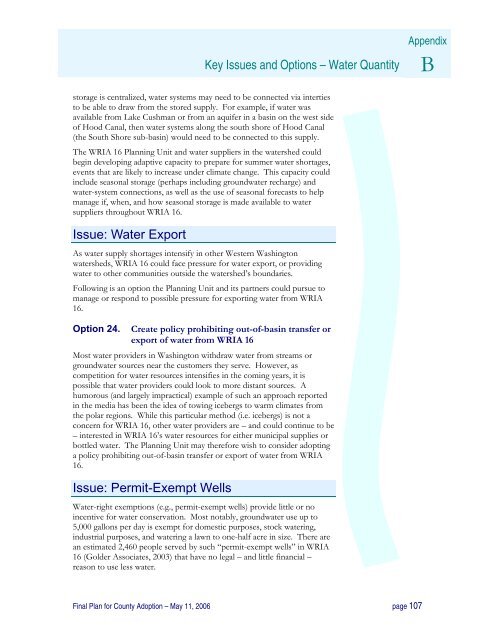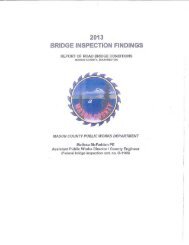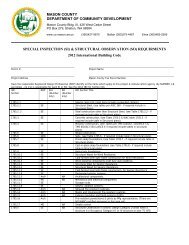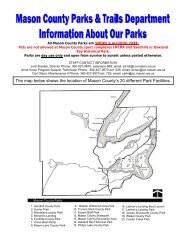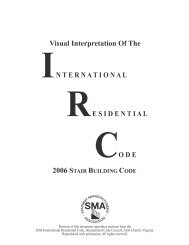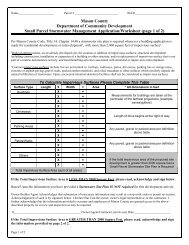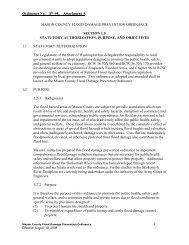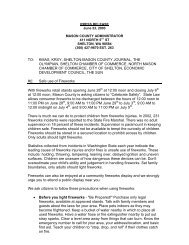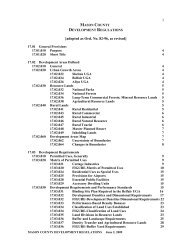Watershed Management Plan - Mason County
Watershed Management Plan - Mason County
Watershed Management Plan - Mason County
Create successful ePaper yourself
Turn your PDF publications into a flip-book with our unique Google optimized e-Paper software.
Key Issues and Options – Water Quantity<br />
Appendix<br />
B<br />
storage is centralized, water systems may need to be connected via interties<br />
to be able to draw from the stored supply. For example, if water was<br />
available from Lake Cushman or from an aquifer in a basin on the west side<br />
of Hood Canal, then water systems along the south shore of Hood Canal<br />
(the South Shore sub-basin) would need to be connected to this supply.<br />
The WRIA 16 <strong>Plan</strong>ning Unit and water suppliers in the watershed could<br />
begin developing adaptive capacity to prepare for summer water shortages,<br />
events that are likely to increase under climate change. This capacity could<br />
include seasonal storage (perhaps including groundwater recharge) and<br />
water-system connections, as well as the use of seasonal forecasts to help<br />
manage if, when, and how seasonal storage is made available to water<br />
suppliers throughout WRIA 16.<br />
Issue: Water Export<br />
As water supply shortages intensify in other Western Washington<br />
watersheds, WRIA 16 could face pressure for water export, or providing<br />
water to other communities outside the watershed’s boundaries.<br />
Following is an option the <strong>Plan</strong>ning Unit and its partners could pursue to<br />
manage or respond to possible pressure for exporting water from WRIA<br />
16.<br />
Option 24.<br />
Create policy prohibiting out-of-basin transfer or<br />
export of water from WRIA 16<br />
Most water providers in Washington withdraw water from streams or<br />
groundwater sources near the customers they serve. However, as<br />
competition for water resources intensifies in the coming years, it is<br />
possible that water providers could look to more distant sources. A<br />
humorous (and largely impractical) example of such an approach reported<br />
in the media has been the idea of towing icebergs to warm climates from<br />
the polar regions. While this particular method (i.e. icebergs) is not a<br />
concern for WRIA 16, other water providers are – and could continue to be<br />
– interested in WRIA 16’s water resources for either municipal supplies or<br />
bottled water. The <strong>Plan</strong>ning Unit may therefore wish to consider adopting<br />
a policy prohibiting out-of-basin transfer or export of water from WRIA<br />
16.<br />
Issue: Permit-Exempt Wells<br />
Water-right exemptions (e.g., permit-exempt wells) provide little or no<br />
incentive for water conservation. Most notably, groundwater use up to<br />
5,000 gallons per day is exempt for domestic purposes, stock watering,<br />
industrial purposes, and watering a lawn to one-half acre in size. There are<br />
an estimated 2,460 people served by such “permit-exempt wells” in WRIA<br />
16 (Golder Associates, 2003) that have no legal – and little financial –<br />
reason to use less water.<br />
Final <strong>Plan</strong> for <strong>County</strong> Adoption – May 11, 2006 page 107


